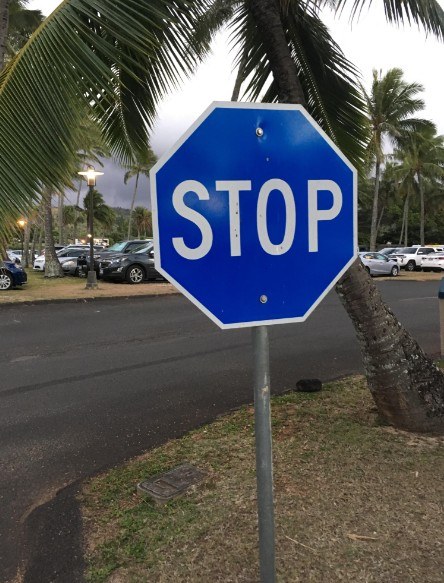If you’ve ever spotted a blue stop sign and done a double take, you’re not alone. Most of us are used to seeing the classic red octagon with bold white letters telling us to “STOP.” So when a blue version appears, it can feel downright strange. Are they even real? Do you have to obey them? Let’s break it down.

Blue Stop Signs Are Real—But They’re Not Government-Issued
First, yes—blue stop signs do exist. However, they’re not officially sanctioned by the U.S. Department of Transportation (DOT). That means you won’t see them on public highways, interstates, or city roads. Instead, blue stop signs are typically installed on private property—places like:
-
Gated residential communities
-
Private college or corporate campuses
-
Large parking lots
-
Amusement parks or privately owned roadways
In these spaces, property owners or management companies can install signage that fits their specific needs—even if those signs don’t conform to national standards.
The History Behind Stop Sign Colors
To understand why blue stop signs stand out so much, it helps to know a little history.
Back in the 1910s, stop signs were yellow with black lettering. The idea was to grab drivers’ attention without being too harsh on visibility—especially in lower light. But as traffic increased and roads got busier, safety experts realized that yellow was being used for too many different types of signs. This led to confusion.
By the 1950s, red became the go-to color for stop signs. Red already carried a psychological association with warnings and danger. Think of stoplights, warning lights, or even fire alarms—red commands attention. That’s why today’s red stop signs feel so intuitive: they’ve been the standard for over 70 years.
What Do Traffic Sign Colors Mean?
Colors on traffic signs aren’t just chosen at random. Each shade has a specific meaning that helps drivers make quick, informed decisions. Here’s a quick rundown:
-
Red: Stop or prohibition
-
Yellow: General warning or caution
-
Green: Directional guidance or permitted movement
-
Blue: Services or informational signs (like hospital or rest stop signs)
-
White and black: Regulatory signs, such as speed limits or lane use
So where does a blue stop sign fit in? The truth is, it doesn’t—at least not within the official U.S. traffic sign system. That’s why they’re not used on public roadways. A blue stop sign breaks the traditional rules of traffic signage, making it a curiosity rather than a standard.
Are You Legally Required to Stop at a Blue Stop Sign?
On public roads, a blue stop sign would be non-enforceable, meaning law enforcement typically won’t issue a ticket for ignoring one. But when it comes to private property, the story changes.
While not legally binding in the way a red stop sign is, blue stop signs still serve a purpose—usually to control traffic flow, improve safety, and prevent accidents. Ignoring them can still have consequences:
-
You could violate the rules of the property and face penalties (like being banned or fined).
-
If you’re involved in an accident, ignoring the sign might count against you in terms of liability.
-
In some jurisdictions, private property rules may still be enforceable by local police, especially if there’s a formal agreement or risk to public safety.
In short, when you see a blue stop sign, treat it like a red one—especially if you’re in a parking lot, gated community, or business complex. Better safe than sorry.
So Why Use a Blue Stop Sign at All?
Great question. If red is the standard, why bother with blue?
In many cases, property managers choose blue to differentiate private roadways from public ones. It’s a way of saying, “This is our property, and we operate under our own rules.” It might also be used for aesthetic reasons—some neighborhoods or companies prefer signage that matches their design theme.
Others might install blue stop signs just because they’re available and inexpensive. Online retailers and signage companies offer them for private use, and since they’re not regulated, buyers have a lot of freedom.
The Takeaway
While blue stop signs might seem unusual, they’re more common than you’d think—especially if you’re paying attention in parking garages or gated neighborhoods. They may not carry the same legal weight as their red counterparts, but they still play an important role in keeping traffic flowing safely on private property.
The next time you see one, don’t dismiss it. Treat it like any other stop sign. Even if it’s not “official,” it’s still there for a reason.





